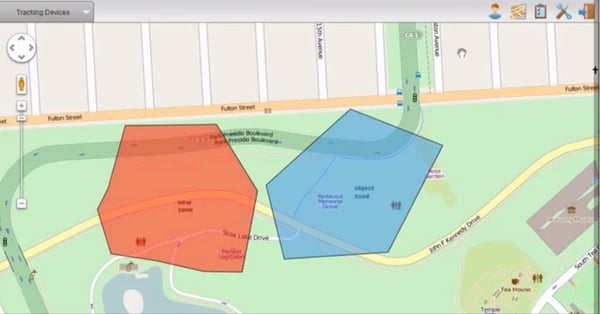
What is Geofencing, and how can you unlock its power in field service Management?
What is Geofencing?
Geofencing is a powerful technology that enables businesses to create digital boundaries or virtual perimeters around specific geographic locations using GPS or RFID technology.
These digital boundaries trigger actions or notifications when a mobile device enters or exits the designated area. It's like setting up a virtual fence around a physical location, allowing businesses to monitor and manage activities within that area with unparalleled precision.

Example of a geofence(Source: Wikipedia)
What are the benefits of geofencing in field service management?
Geofencing can be leveraged to achieve a wide range of benefits in field service management. Here are some of the most significant advantages:
Optimised Workforce Management: With geofencing, businesses can monitor the real-time location of field service technicians and assign tasks more efficiently based on proximity to customer sites. This minimises travel time, optimises technician schedules, and enhances workforce management.
Precision Time Tracking and Attendance: Geofencing gives businesses accurate insights into technicians' arrival and departure from job sites, ensuring precise timekeeping for payroll purposes and allowing firms to validate task completion within specified timeframes. With geofencing, businesses can effectively manage attendance and ensure compliance with service-level agreements.
Automated Job Dispatching: By integrating geofencing with field service management systems, businesses can automate the dispatching of work orders based on technician proximity. When a technician enters a geofenced area, the system can automatically assign relevant tasks, minimising response times and improving overall efficiency.
Route Optimisation: Geofencing allows businesses to define service territories for technicians and optimise routes based on historical data and real-time traffic conditions. By analysing these factors, companies can identify the most efficient routes for technicians, minimising travel time and fuel costs. Route optimisation improves operational efficiency and enhances the overall productivity of field service teams.
Streamlined Customer Communication: With geofencing, businesses can send automated notifications to customers when a technician is en route or has arrived at their location. These notifications provide customers with real-time updates on service appointments, enhancing communication and transparency throughout the service delivery process. Improved communication leads to higher levels of customer satisfaction and loyalty.
Efficient Asset Tracking: Geofencing can also be used to track the location of valuable assets such as equipment and vehicles. By setting up geofenced areas around storage facilities or job sites, businesses can monitor the movement of assets in real-time. This helps deter theft or unauthorised use of assets and ensures optimal utilisation of resources.
What sort of businesses can use Geofencing?
Any field service management business can make use of geofencing, but some of the most prevalent are:
1. HVAC Services: A heating, ventilation, and air conditioning (HVAC) company can use geofencing to optimise technician routes and respond quickly to service calls. When a customer requests service, the system can automatically dispatch the nearest available technician based on their location. As the technician approaches the customer's location, the system sends an automated notification to the customer, informing them of the technician's estimated arrival time.
2. Utility Maintenance: Utility companies responsible for maintaining infrastructure such as power lines or pipelines can use geofencing to monitor technician movements and ensure compliance with safety regulations. By setting up geofenced areas around high-risk sites or restricted zones, the company can receive real-time alerts if technicians enter these areas without proper authorisation, helping prevent accidents and ensure regulatory compliance.
3. Telecommunications: Telecommunications companies that provide field service for installing or repairing network infrastructure can use geofencing to optimise technician dispatching and improve service efficiency. When a customer reports a network issue, the system can automatically assign the nearest technician with the required skills to resolve the issue. Geofencing can also be used to track technician movements during installations or repairs, ensuring the timely completion of tasks.
4. Property Maintenance: Property management companies responsible for maintaining residential or commercial properties can use geofencing to monitor the activities of maintenance crews and ensure the timely completion of tasks. By setting up geofenced areas around properties, the company can track when maintenance crews arrive and depart from each location, verify the completion of scheduled tasks, and provide real-time updates to property owners or tenants.
Optimising Field Service Operations with Geofencing:
To fully capitalise on the benefits of geofencing, businesses need to implement a strategic approach to its implementation and utilisation. Here are some critical strategies for optimising field service operations with geofencing:
1) Define Clear Objectives: Before implementing geofencing technology, businesses must clearly define their objectives and identify specific use cases where geofencing can add value.
2) Select the Right Technology: Businesses should thoroughly evaluate their options and choose a technology that aligns with their needs and requirements.
3) Integrate with Existing Systems: Geofencing should seamlessly integrate with existing field service management systems and workflows to ensure smooth operations.
4) Train and Educate Staff: Proper training and education ensure field service teams understand how to use geofencing technology effectively.
5) Monitor and Analyse Performance: Regular monitoring and analysis of geofencing data can help businesses identify areas for improvement and optimise operations.